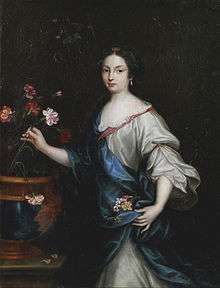Claude de Vin des Œillets
Claude de Vin des Œillets, known as Mademoiselle des Œillets (French: [dɛz‿œjɛ]; Provence 1637 – Paris, 18 May 1687), was a mistress of King Louis XIV of France and the companion of the official royal mistress and favourite Madame de Montespan.[1] She was known for her involvement in the famous Affair of the Poisons (1679–1680).[2]
Claude de Vin des Œillets | |
|---|---|
| Mademoiselle des Œillets | |
 Portrait by Mignard | |
| Full name
Claude de Vin des Œillets | |
| Born | 1637 Provence, France |
| Died | 18 May 1687 (aged 50) Paris, France |
| Issue | |
| Father | Nicolas de Vin |
| Mother | Louise Faviot |
Daughter of the actors Nicolas de Vin and Louise Faviot, considered the best tragic actress of the 1660s, during which created the leading roles in several tragedies of Pierre Corneille (Sertorius, Sophonisbe, Otto) and Jean Racine. She became the trusted companion of Montespan. During the Affair of the Poisons, she was said to have made more than fifty visits to the poisoners.[3] she was pointed out as the replacement of Montespan in the black masses. She was protected from any persecution by the monarch and Colbert, but the affair implicated Montespan and ruined the latter's relationship with the king.[4]
Œillets retired from court in 1678 to a comfortable life in her Paris residence and country estate until her death.
- She had a child by the king, Louise de Maisonblanche (17 June 1676 – 12 September 1718), later "Baroness of La Queue" by marriage. The king never recognised her as his daughter.
References
- Riley, Philip (2001). A lust for virtue: Louis XIV's attack on sin in seventeenth-century France. Philanderings. p. 90.
- Somerset, Anne (2004). The Affair of the Poisons: Murder, Infanticide, and Satanism at the Court of Louis XIV. Principal Characters of the Affairs of the Poisons: St. Martin's Press. p. xvii. ISBN 0312330170.
- Macdonald, Roger (2005). The Man in the iron mask. Constable. p. 197.
- Mossiker, Frances (1970). The affair of the poisons: Louis XIV, Madame de Montespan, and one of history's great unsolved mysteries. Knopf. p. 169.